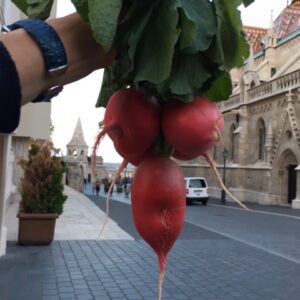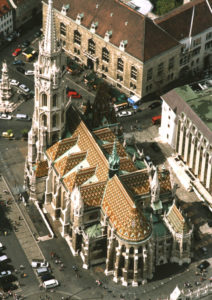 Let me tell you about the radishes here in Budapest. Maybe you have such radishes where you live, but, for me, radishes this big and tasty come only from the “paprika capital” of the world: Hungary.
Let me tell you about the radishes here in Budapest. Maybe you have such radishes where you live, but, for me, radishes this big and tasty come only from the “paprika capital” of the world: Hungary.
Eating Hungarian radishes is like biting into an apple—juicy but crisp, sweet but pungent. I try to talk myself out of buying them every time I come to Budapest. I don’t really need them: the tour I’m leading includes marvelous meals.
But each time I’m here, a bunch of radishes rolls off the shelf and leaps into my arms. As if they are contraband, I tuck them under my jacket and sneak them into my room at the Castle Hilton. Phew. We are safe!
Sometimes travel comes down to things like radishes. The richness of intense travel can be overwhelming. In my work, I interact with a lot of different people on these tours: from fifth-graders to nonagenarians. Nearly all are encountering the details of hitherto unfamiliar histories for the first time. We’re traveling through places with complex stories like Russia, Poland, and Croatia. At a certain point, the tidal wave of information overwhelms the body, soul, and mind. Names like Vaclav, Sigismund, Kasimir, and Ivan somehow blend together into a single towering king, legendarily responsible for every dynastic disaster or accomplishment. Who can sort it out?
That’s why radishes help. Radishes, or something else simple that pegs the places we’re visiting. It’s easier to learn when we encounter things on simpler terms. For example, everyone is dazzled by the luminescent Zsolnay tiles that bedeck the magnificent roof of St. Mathias Church. But how can our eyes take in that beauty? How can they remember it?

One strategy might be visiting a shop and buying a tiny figurine cast in the same Zsolnay porcelain. It could be a bird, a cross, or a miniature gargoyle. It will be colorful and luminescent, fit in a pocket or hang as a pendant. Most importantly, it will long serve as a reminder of the beauty experienced.
Some simple reminders are intangible, particularly smells and sounds. In Krakow, everyone’s heart is stolen by the Trumpeter of Krakow. The ancient tune resounds from the tower of St. Mary’s Church that overlooks the vast, opulent square. The trumpeters (a small brigade of professionals) play this brief, oddly truncated fanfare every hour on the hour, 24 hours a day, 7 days a week, 365 days a year. And they play it in 4 directions, opening the tower windows to the West, South, East, and North. By doing this, they not only stamp a musical signature on Krakow, but they evoke a centuries’ old practice when such church towers were the best watch towers for spotting an advancing army.
A personal favorite travel fragrance of mine comes also from Krakow. Their signature gingerbread, called Pierniki, is baked as small, dense biscuits shaped into hearts, diamonds, and clubs and dusted with a light coating of powdered sugar. Like every point of local pride, it is allegedly the “best in the world.” Those legendary kings probably gobbled it up as heartily as we moderns do.
The simple things can take the form of ritual visits. In Bratislava, once our official walking tour concludes, I walk to an inelegant, out-of-the-way shop where they print T-shirts decorated with patterns taken from ancient Slavic culture. These shirts aren’t cheap, but they last and last. I buy one occasionally and get so much pleasure from wearing it, particularly when people say “Wow, where’d you get that?” I can answer “Bratislava,” which, as you might guess, opens up an opportunity to talk about Slovakia—a gorgeous country not on everyone’s radar.
Maybe the most beautiful ritual visit I make happens late at night in Vilnius, Lithuania. The small, street-side chapel called Holy Trinity Church is the site of a beloved icon known as the “Image of Divine Mercy.” Around the clock, the icon gazes tenderly at the enthusiastic, predominantly young worshipers who keep vigil around the clock, often singing spontaneously in Lithuanian and Latin.
People say to me: “You are soooo lucky to be able to do what you’re doing.” Boy, are they right. I’m the girl who, even in high school, wondered if I’d ever get beyond my back yard. People from my childhood traveled only in books.
But I have gotten out of that yard. I even got across the little mountain called Round Hill that rose up behind our neighborhood. I now regularly cross the Atlantic between six and ten times a year. I know where to find the creamiest ice cream in Weimar and the strongest hot chocolate in Tallinn. And when needed, after review, I can rattle off the history of the Hapsburg, Jagiellonian, or Romanov dynasties with minimal effort.
But the radishes help. The little things that are real to us today help us to grasp the difficult and puzzling things of history. Indeed, small connections weave a thread that will draw us through the complex tapestry of the past. The small, beautiful things we encounter inevitably remind us of how humans have risen from the ashes, surviving the horrifying and disastrous events that define history.
So next time I will bear my radishes proudly through the lobby of the Budapest Castle Hilton. To the elegantly dressed concierge, I will smile, and point to my radishes. “You have an astonishing country, sir. And amazing radishes.” He might just understand and smile back!



